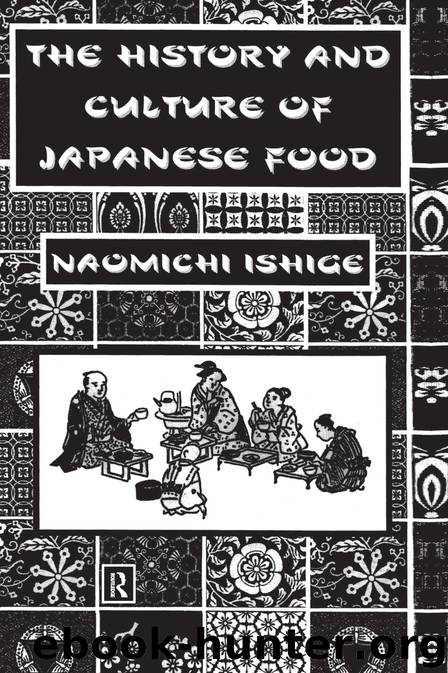History Of Japanese Food by Ishige

Author:Ishige, [Naomichi Ishige]
Language: eng
Format: epub
ISBN: 9781136602542
Publisher: Taylor and Francis
CHAPTER 6
Changes in the Modern Age
6.1 Historical Setting
While Japan was confined to its own microcosm under the national seclusion policy of the Tokugawa shoguns, Europe and America were transformed by the industrial revolution and the rapid development of capitalism. Western nations acquired immense economic and military strength, and the great powers moved into Asia in search of markets and resources.
In 1853, a squadron of American warships suddenly appeared in Edo Bay. Commodore Perry presented the shogunate with a presidential letter demanding that Japan be opened for trade, and indicated that a failure to respond would be met by military action. By 1858 Japan had been forced to conclude commercial treaties with the United States, Britain, France, the Netherlands and Russia, designating several ports where ships from those nations could land for trade and foreign nationals would be allowed to reside. The treaties contained unequal provisions giving foreigners immunity from Japanese law and denying Japan the right to set tariffs autonomously.
In reaction to the treaties which had been forcibly imposed by foreign states, a movement arose that demanded the expulsion of foreigners from Japan, Meanwhile, trade developed under the treaty arrangements, with raw silk and tea as the main export products and woolens, cotton goods and arms as major imports. Domestic prices rose as a result of the foreign trade, making life difficult for the lower-ranking samurai and the peasants. All the open ports were located in the shogunal domains of the Tokugawa clan, and other feudal clans grew displeased with their monopolization of the profits. The petty samurai displayed increasing antipathy toward the merchants who profited from foreign trade. These veins of social discontent coalesced with the movement to expel foreigners, gaining a momentum that threatened to topple the shogunate. The petty samurai were the driving force of the movement, and their leaders decided they should overthrow the shogun and give power to the emperor, who for centuries had held sovereignty in name only. After minor military clashes between the shogunate and several feudal clans of western Japan which supported the rebellion, the shogun recognized that he had lost the capacity to govern and handed over to the emperor. That return of power to the imperial house in 1868, known as the Meiji Restoration, marked the start of the modernization of Japan.
The emperor soon moved from Kyoto to the abandoned shogun's castle in Edo, and Edo became the official capital, renamed Tokyo. The fiefs of the daimyo were abolished, and the centralized government that was formed under the emperor pressed strongly forward with the formation of a modern state along Western lines. Its chief aims were to stimulate an industrial revolution in Japan by transplanting modern industry from the West, and to build a modern army based on conscription. For those purposes it was deemed necessary to introduce a modern educational system and to ensure an ample supply of stout soldiers and labourers.
The learned men of the time who had acquired information from the West believed that one reason why
Download
This site does not store any files on its server. We only index and link to content provided by other sites. Please contact the content providers to delete copyright contents if any and email us, we'll remove relevant links or contents immediately.
| Anthropology | Archaeology |
| Philosophy | Politics & Government |
| Social Sciences | Sociology |
| Women's Studies |
Born to Run: by Christopher McDougall(7065)
The Leavers by Lisa Ko(6911)
iGen by Jean M. Twenge(5366)
Sapiens by Yuval Noah Harari(5294)
The Kite Runner by Khaled Hosseini(5084)
Spare by Prince Harry The Duke of Sussex(5072)
Machine Learning at Scale with H2O by Gregory Keys | David Whiting(4179)
Bullshit Jobs by David Graeber(4095)
Never by Ken Follett(3790)
Goodbye Paradise(3728)
Livewired by David Eagleman(3684)
Fairy Tale by Stephen King(3220)
A Dictionary of Sociology by Unknown(3031)
Harry Potter 4 - Harry Potter and The Goblet of Fire by J.K.Rowling(2990)
The Social Psychology of Inequality by Unknown(2940)
The Club by A.L. Brooks(2862)
Will by Will Smith(2793)
0041152001443424520 .pdf by Unknown(2784)
People of the Earth: An Introduction to World Prehistory by Dr. Brian Fagan & Nadia Durrani(2701)
